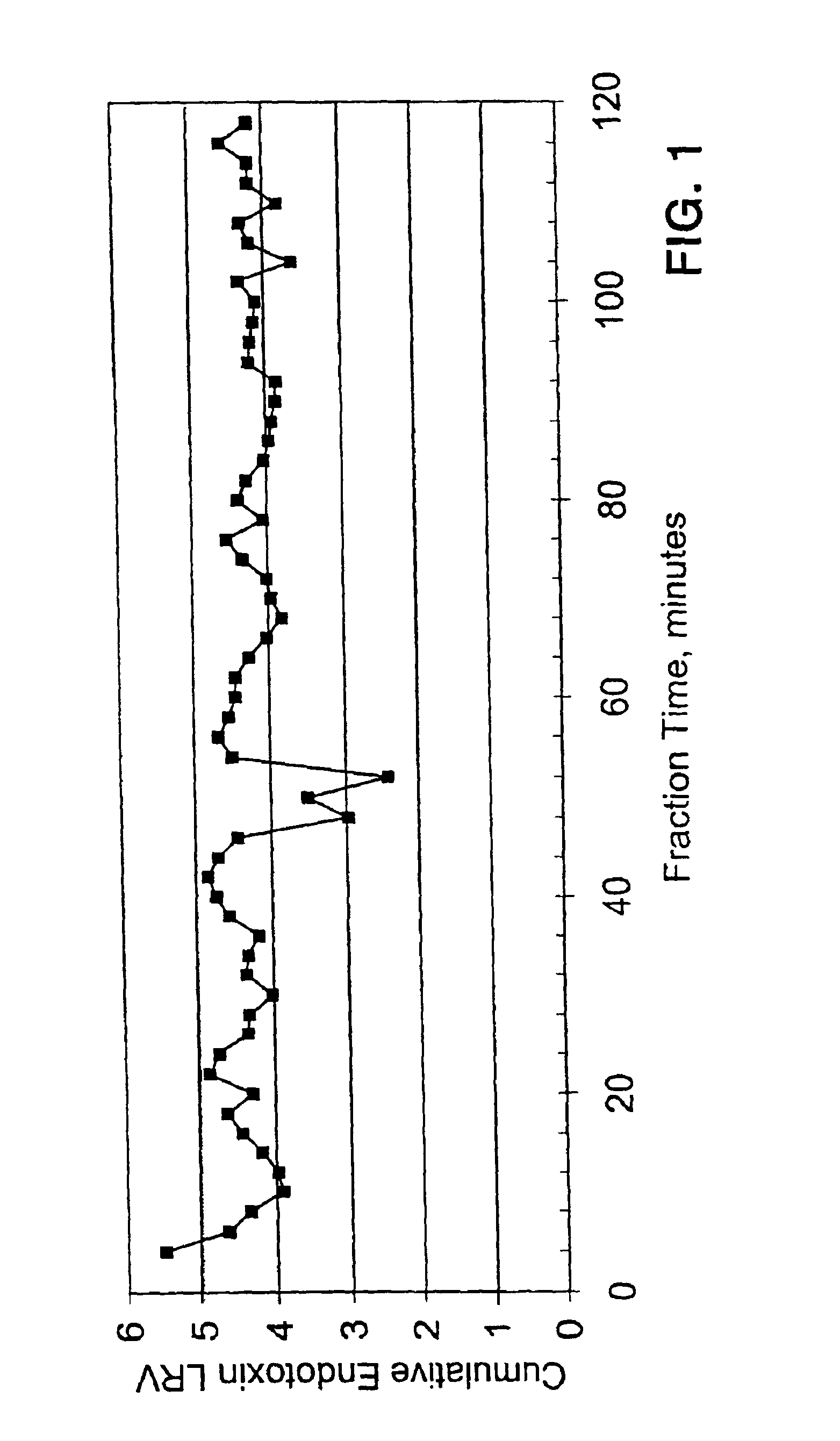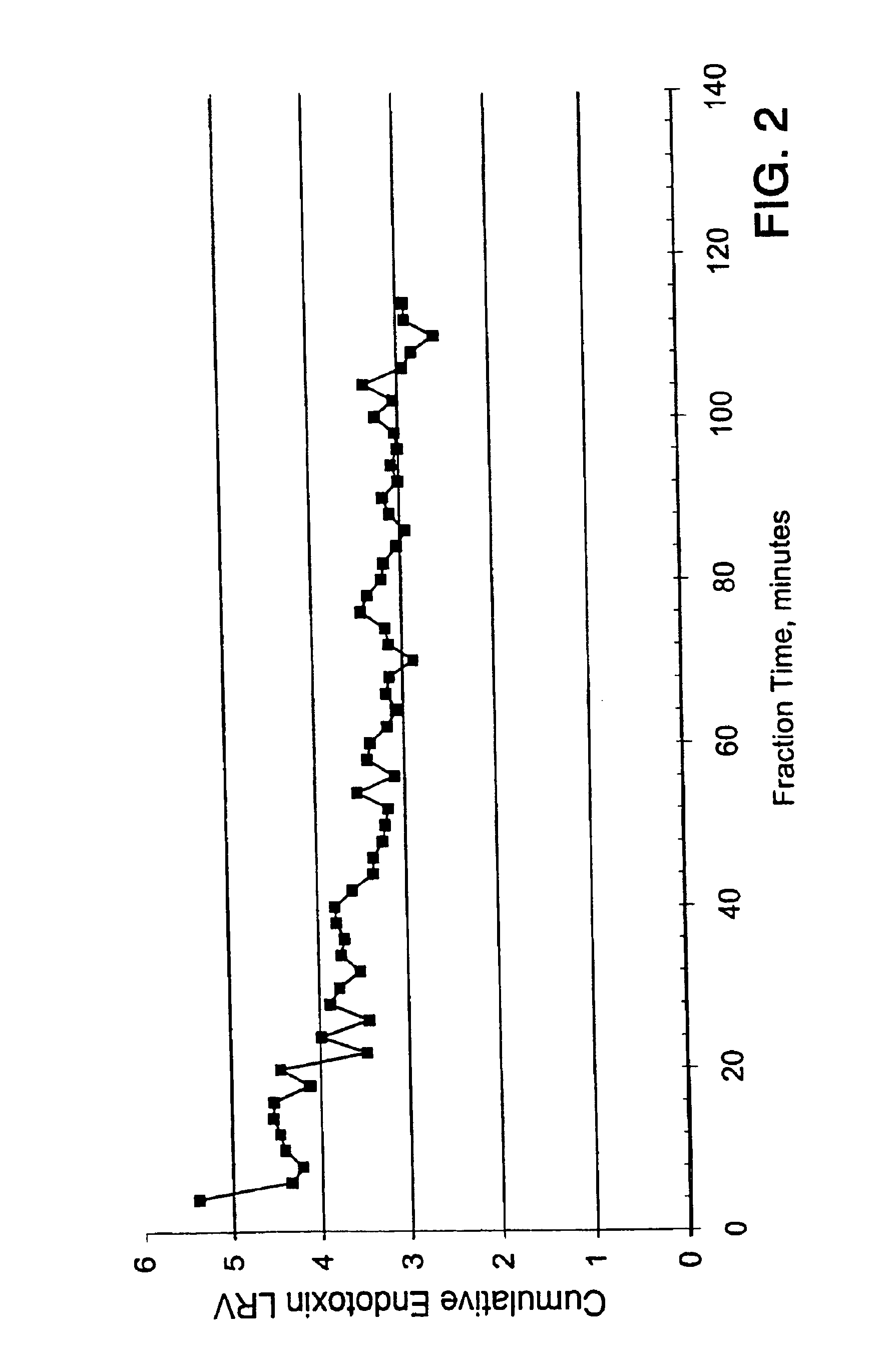Charged membrane
a charge membrane and hydrophilic technology, applied in water/sewage treatment by ion exchange, filtration, disinfection, etc., can solve the problems of low binding capacity of contaminants, limited bacterial contaminant removal efficiency of some of these membranes, and low water flow rate of membranes
- Summary
- Abstract
- Description
- Claims
- Application Information
AI Technical Summary
Problems solved by technology
Method used
Image
Examples
example 1
This Example illustrates a method of preparing a membrane of the present invention by the phase inversion method and its properties.
IngredientsWt. %Polyethyleneglycol62.3Polyethersulfone13.0Deionized water1.5Glycerol1.0N,N-Dimethylformamide10.0N-methylpyrrolidone7.6Ammonium persulfate0.1Ethyleneglycol dimethacrylate1.5N-{3-(dimethylamino)propyl}1.5methacrylamide3-{(Methacryloylamino)-1.5propyl}trimethylammonium chloride
The above ingredients were combined and mixed at 130° F. for 18 hours. The resulting solution was degassed and cast onto a supporting surface, and phase inversion was carried out by exposure to water vapor. The resulting membrane was washed with deionized water and dried. The membrane had an open water bubble point of 55 psi; a water flow rate of 25.5 mL / minute / cm2 at 10 psi (0.68 bar); a thickness of about 6.0)6.1 mils (150-153 μm); and a Metanil Yellow Dye binding capacity of 386 mL, 10 ppm solution at pH 6.6, at a ΔP of 10 psi (0.68 bar). A 15% NaCl solution wet th...
example 2
This Example illustrates the ability of the membrane described in Example 1 to retain endotoxin. The membrane was tested as follows. A 25 mm diameter membrane disk having an effective filtration area (EFA) of 3.7 cm2 was challenged with a sterile, nonpyrogenic 0.9% Sodium Chloride for Injection USP (McGraw) spiked with a target of 10,000 EU / mL of purified E. coli 055:B5 endotoxin at a flow rate of 1 ml / min. Effluent fractions were collected and the endotoxin content of each fraction was determined using a kinetic, chromogenic Limulus Ameobocyte Lysate (LAL) assay (Charles River Labs Endochrome K kit). A standard curve was prepared by using sterile, nonpyrogenic 0.9% Sodium Chloride for Injection USP (saline) as the diluent
The log reduction value (LRV) of each filtrate fraction was determined. The actual challenge endotoxin concentration was 15,543 EU / mL. The fluid flow rate was 1 ml / min. The LRV results obtained are shown graphically in FIG. 1. The membrane had an endotoxin binding ...
example 3
This Example illustrates the preparation of a membrane comprising a hydrophobic porous substrate and coating comprising a charge-providing agent.
A hydrophobic porous polyethersulfone substrate was prepared from a casting solution containing polyethylene glycol 400 69.4%, polyethersulfone 13.0%, Reverse Osmosis treated water 1.5%, glycerol 3.5%, N,N-dimethylformamide 10.0%, and N-methylpyrrolidone 7.6%, all percentages by weight of the casting solution. The membrane had a nominal pore size of 0.2 pan.
A coating solution was prepared from the following ingredients.
IngredientsWt. %Water94.5Potassium hydroxide1.0Epichlorohydrin modified2.0polyethyleneimineQuaternized poly(dimethylamine-co-2.5epichlorohydrin)
The coating solution was prepared by combining and mixing the above ingredients for about 1 hour. The pH of the solution was adjusted to approximately 10.6 using a 20% potassium hydroxide solution immediately before use. The hydrophobic polyethersulfone was prewet in ethanol, rinsed i...
PUM
| Property | Measurement | Unit |
|---|---|---|
| surface tension | aaaaa | aaaaa |
| pore size | aaaaa | aaaaa |
| pore size | aaaaa | aaaaa |
Abstract
Description
Claims
Application Information
 Login to View More
Login to View More - R&D
- Intellectual Property
- Life Sciences
- Materials
- Tech Scout
- Unparalleled Data Quality
- Higher Quality Content
- 60% Fewer Hallucinations
Browse by: Latest US Patents, China's latest patents, Technical Efficacy Thesaurus, Application Domain, Technology Topic, Popular Technical Reports.
© 2025 PatSnap. All rights reserved.Legal|Privacy policy|Modern Slavery Act Transparency Statement|Sitemap|About US| Contact US: help@patsnap.com



